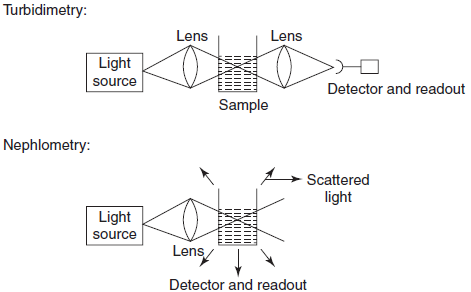Determination of Turbidity in Water
INTRODUCTION
Turbidity is a measure of degree at which the water loses its transparency because of the presence of suspended particles. The amount of total suspended solids in the water is high, then that water sample has higher turbidity. The scattering or absorption of light by solid or colloidal particles suspended in solution is the basis of nephelometry and turbidimetry. When light passes through the suspension, some of the incident radiant energy is dissipated through absorption, reflection, and reaction, while the rest is transmitted.

Fig: Principle of Nephelometry and Turbidimetry
(Source: http://rxpharmaworld.blogspot.com/2016/12/nephelometry-and-turbidimetry.html)
There are various parameters influencing the turbidity/cloudiness of the water. Some of these are :
- Algae growth
- Phytoplankton
- Sediments from erosion
- Resuspended sediments from the bottom
- Waste discharge
- Urban runoff
Turbidity guidelines for drinking water :
For drinking water supplies, the following guidelines should be taken into consideration :
- Drinking water should have a turbidity of 5 NTU/JTU or less
- Turbidity of more than 5 NTU/JTU would be noticed by users and may cause rejection of the supply
- Where water is chlorinated, turbidity should be less than 5 NTU/JTU
- Preferably less than 1 NTU/JTU for chlorination to be effective
Measuring Turbidity :
Turbidity can be measured using either an electronic turbidity meter or a turbidity tube. Both methods have advantages and disadvantages, as shown below. Turbidity is usually measured in Nephelometric Turbidity Units (NTU) or Jackson Turbidity Units (JTU), depending on the method used for measurement. The two units are roughly equal. JTU is measured with the Jackson candle turbidimeter. This unit is no longer used.
Consequence of high Turbidity :
The suspended solid in water absorb heat from the sunlight, making the temperature of turbid water higher become and therefore reducing the concentration of O2 in the water as oxygen dissolves better in lower temperature. The suspended solid in water scatter the light falling on it, thus decreasing the photosynthetic activity of plants and algae, which results in lower oxygen concentration in water. Therefore particles settling to the bottom, shallow lakes fill in faster, fish eggs and insect larvae are covered and suffocated, gill structures get clogged or damaged.
Relevant Indian Standard for Turbidity Test :
- IS 3025 (Part 10)-1983: Method of Sampling and Test (Physical and Chemical) for Water and Wastewater : Turbidity, (First Revision).
